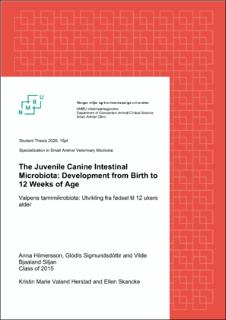| dc.contributor.advisor | Skancke, Ellen | |
| dc.contributor.advisor | Valand Herstad, Kristin Marie | |
| dc.contributor.author | Hilmersson, Anna | |
| dc.contributor.author | Sigmundsdóttir, Glódís | |
| dc.contributor.author | Vilde, Bjaaland Siljan | |
| dc.date.accessioned | 2020-12-14T13:56:40Z | |
| dc.date.available | 2020-12-14T13:56:40Z | |
| dc.date.issued | 2020 | |
| dc.identifier.uri | https://hdl.handle.net/11250/2719243 | |
| dc.description.abstract | En litteraturgjennomgang ble foretatt for å karakterisere utviklingen av tarmmikrobiotaen hos valper fra fødsel til 12 ukers alder. Valper som fødes med mekonium/placenta som inneholder dyrkbare bakterier og valper som fødes vaginalt, oppnår økt tilvekst sammenlignet med valper som fødes med mekonium/placenta uten dyrkbare bakterier eller som tas med keisersnitt. I løpet av de 3 første ukene dominerer Firmicutes i valpens tarmmikrobiota og de vanligste melkesyrebakteriene er Lactobacillus johnsonii og L. animalis. Før avvenning er valpens tarmmikrobiota ulik morens tarmmikrobiota. Ved avvenning derimot (omtrent 6-8 ukers alder) vil valpens tarmmikrobiota bli likere moren tarmmikrobiota, dette er trolig på grunn av overgangen fra melk til fast føde sammen med atferdsmessige faktorer. På dette tidspunktet har diversiteten i tarmfloraen økt og de vanligste bakterielle rekkene er Fusobacteria, Bacteroidetes, Firmicutes, Proteobacteria og Actinobacteria. L. johnsonii er ikke lenger dominerende mens L. animalis har fortsatt hyppig forekomst.
Små studiepopulasjoner og mangelfull informasjon angående prøvehåndtering er områder som kan forbedres i fremtidige studier av hundens tarmmikrobiota. Hvilken rolle som oppvekstmiljøet og mikrobiotaen i melk har på utviklingen av tarmmikrobiotaen hos valper, krever videre studier. Aldersrelaterte endringer av de forskjellige artene av melkesyrebakterier burde tas hensyn til når probiotikum utformes til hund. | en_US |
| dc.description.abstract | A literature review was performed to characterize the development of the intestinal microbiota (IM) in puppies from birth to 12 weeks of age. Puppies born with meconium/placenta harbouring cultivable bacteria, and puppies born vaginally gain more relative weight compared to puppies born without cultivable bacteria in meconium/placenta or delivered by caesarean section. During the first 3 weeks, the puppy’s IM is dominated by Firmicutes and the most common lactobacilli are Lactobacillus johnsonii and L. animalis. Prior to weaning the puppies IM is dissimilar to their mothers IM but at weaning (approximately age 6-8 weeks), it becomes more similar, likely due to the transition from milk to solid food together with behavioural factors. At this time the diversity has increased, the main phyla found are Fusobacteria, Bacteroidetes, Firmicutes, Proteobacteria and Actinobacteria. L. johnsonii is no longer dominant while L. animalis is still abundant.
Small study populations and lack of information regarding sample handling can be improved in future studies of the IM in dogs. Whatever the role of the rearing environment and microbiota in milk has on the IM development in puppies needs to be studied further. Age related changes of lactobacilli strains should be considered when designing probiotics for dogs. | en_US |
| dc.language.iso | eng | en_US |
| dc.publisher | Norwegian University of Life Sciences, Ås | en_US |
| dc.rights | Attribution-NonCommercial-NoDerivatives 4.0 Internasjonal | * |
| dc.rights | Attribution-NonCommercial-NoDerivatives 4.0 Internasjonal | * |
| dc.rights.uri | http://creativecommons.org/licenses/by-nc-nd/4.0/deed.no | * |
| dc.title | The Juvenile Canine Intestinal Microbiota: Development from Birth to 12 Weeks of Age | en_US |
| dc.title.alternative | Valpens tarmmikrobiota: Utvikling fra fødsel til 12 ukers alder | en_US |
| dc.type | Student paper, others | en_US |
| dc.source.pagenumber | 64 | en_US |
| dc.description.localcode | VET | en_US |

